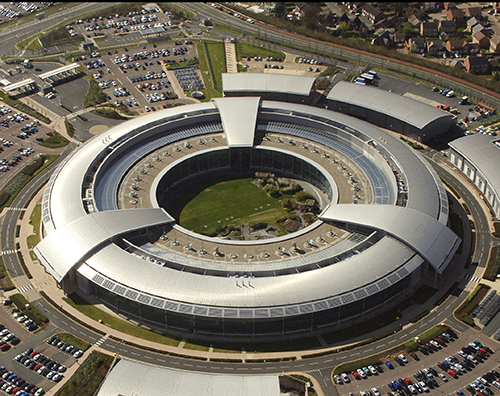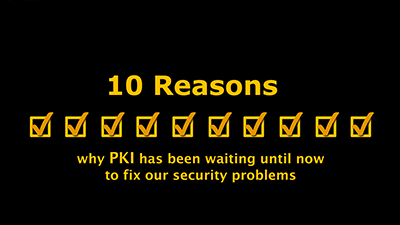Why wasn’t asymmetric cryptography built into the internet from the start?
For one thing, back then only supercomputers were capable of performing the complex operations that asymmetric cryptography calls for. Today of course you have a supercomputer in your pocket.
There are other reasons as well. For details, watch
our “Ten Reasons" video.
Over a decade ago an MIT Technology Review cover
story declared “The Internet Is Broken.” And of course
it’s still broken. In fact things have gone from bad to worse.
Privacy. Breaches. It's a mess.
and can do these amazing things, why don’t we see more of it?
Well, in fact, you will find asymmetric cryptography everywhere. You use it when you go to websites whose address starts with https://. It’s in your phone. And yes, it’s essential to blockchain and many other
commonly used technologies.
But these are only bits and pieces of what's
possible. Its originators and others had a much
bigger vision for this amazing technology. What
they were calling “public key infrastructure” (PKI)
was a world information and communications infrastructure that would provide rock-solid security and manageability everywhere. Done right, public key infrastructure would have prevented all the mayhem we now see.
PKIDR is the Key to Your Future
So ...
What the hell is PKIDR ?
In the seventies, an amazing new technology was invented
by a famous British signals intelligence agency. GCHQ – the same agency where Alan Turing’s team of crypto analysts had shortened World War II by cracking the German Enigma code – had come up with the
essentials of this startlingly effective thing called
asymmetric cryptography.
Shortly we’ll show you how asymmetric cryptography
works. But first we need to share with you the sad fact
that for a variety of reasons asymmetric cryptography
has never been properly put to use.
Asymmetric cryptography done right – what we call
PKIDR – can solve all of our major problems with the
use of the internet and phone networks. It can not only eliminate breaches, malware, phishing attacks, spam, online fraud and Silicon Valley’s massive privacy invasions; it can make life simpler and easier for everyone as well.
If asymmetric cryptography has been around so long ...
So why didn't it happen?
For all these years people figured “The security experts will sort this out.”
The security industry has a lot in common ...
with industries selling weight loss schemes, miracle cures for dread diseases, and get-rich-quick schemes. According to one high-profile provider of consulting to the security industry, the revenue rate is a trillion
dollars every four years. If they were to actually
solve the problem, that revenue would drop to a
trickle.
Not to mention other technology companies.
Silicon Valley’s business model is all about stealing
your personal information and putting it on their
balance sheet as a money-making asset. So they certainly don’t want the solid privacy that PKIDR delivers.
Things are getting worse – daily security breaches, privacy under assault. But the solution is hiding in plain sight for those who know where to look.
TM
TM
Its originators and others had a much bigger vision for this amazing technology
Silicon Valley's business model is all about stealing your personal information and putting it on their balance sheet as a money-making asset.
Things have to change
PKIDR will solve all of this
For those who get in early ...
Message to entrepreneurs
Government Communications Headquarters
Cheltenham, England
GCHQ – "The Doughnut"
Remember when the world was swept up in the promise of the amazing possibilities presented by personal computers and the Internet? Now the world wonders whether worms, spam, ransomware, breaches, security vulnerabilities, zombie hosts, human trafficking, child predation, identity fraud, violations of personal privacy and other signs of growing anarchy have betrayed the promise.
Organized crime is taking over the world’s information infrastructure, while that infrastructure claims an increasing portion of our time, attention, and money.
Governments and global organized crime aren’t the only ones who want to control the world’s information and communications infrastructure; a third contender is “Silibandia” – the confluence of Silicon Valley, the broadband/wireless industry, and the media industry.
PKIDR is precisely what we need to keep the information world from being taken over by the Jumanji-like incursion of government, organized crime and Silibandia.
If you agree with the path to the solution presented here, you can help make it all happen!
The Internet used to be characterized as an information highway, and the name still fits. It was and is an outdoor public transport system. Typically we use a highway to take us from one indoor space to another indoor space. Building to building. So where are the online buildings?
In fact, we are keeping our files, holding our meetings, and letting our kids hang out by the side of a busy digital roadway. We’re living and working in cardboard boxes on busy street corners.
The alarming thing is that the perfect construction material for online buildings was invented decades ago. It’s PKI, public key infrastructure. PKI has been deployed in incomplete bits and pieces throughout our information infrastructure, but for a set of really bizarre reasons, it has never been deployed in its completeness.
PKIDR – PKI Done Right – starts with Accountable Anonymity, which works like your car’s license plate. Anyone can see it, making you accountable for what happens on public roadways. But no one gets to know the identity of the driver or owner except when some event, e.g., an accident, compels the disclosure to those affected.
Digital signatures are part of PKIDR – they are ubiquitous, establishing a trail of accountable anonymity everywhere. One example of PKI being deployed in incomplete bits and pieces is blockchain. Blockchain uses digital signatures, but signatures of whom? Blockchain worsens the problem by facilitating untraceable transactions among the perpetrators of all the problems mentioned above.
© 2011-2020 The Authenticity Institute, Inc.








